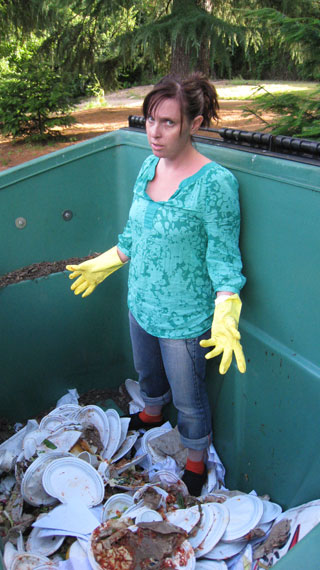The Film Must Go Green

Sustainable Filmmaking Workshop Panelists:
Miranda Bailey – Director, Greenlit
Lauren Selman – Reel Green Media
Eva Radke – Film Biz Recycling
World premiering at SXSW 2010, Miranda Bailey’s documentary, Greenlit, portrays the hopes and eventual challenges of making the production of The River Why “green.” There is a moment at the beginning of Bailey’s documentary where making their film production eco-friendly seems not only doable, but might save them money. They’ve hired a sustainability consultant, the initiative is coming from the producer and Bailey even watches Al Gore’s An Inconvenient Truth. But as the film unfolds, it reveals the difficulties and unexpected push-backs of trying to green your film.
The Green movement in filmmaking has gotten a lot of traction recently, especially after a 2006 UCLA study exposed the Film and television industry as the third biggest polluter in Los Angeles. In response, studios such as FOX and Warner Brothers started emphasizing their green initiatives. Cottage industries related to responsible film productions have taken root, with even a few green film fests sprouting up. SXSW continued its efforts from previous years, having clearly marked recycle bins spread throughout the convention center as well as showcasing three SolarPumps, solar powered charging stations made from recycled parts that can power up everything from scooters to laptops, cell phones and iPods.
But what does this mean for independent filmmakers, where budgets are small, time is short and getting the shot is sometimes all that matters? In Greenlit, the initial goals of greening The River Why are at first met with interest and curiosity, but they are soon forced to make compromises. A hybrid car isn’t available, recycling is difficult on location and Union rules don’t always allow for green initiatives.
During the SXSW Sustainable Filmmaking Workshop, Bailey listed the efforts they attempted to maintain during the filming of The River Why — trying to recycle, reducing bottled water and composting — and questioned their success. Not that she regretted dumpster diving to separate recyclables from trash, but she wondered if it was enough to label her film “green.”
Her fellow panelists, Eva Radke of Film Biz Recycling, and Lauren Selman of Reel Green Media (and the environmental consultant featured in Greenlit), agreed that the newness of sustainable filmmaking is, itself, a problem. There are no standards on labeling a production “green,” it’s not something addressed in film schools and from Bailey’s experience, “people don’t seem to care enough on set.”
As for the financial impact, as a producer, Bailey sees no added cost to green efforts. The money spent in hiring an environmental consultant and for paying a dishwasher to clean their plates and silverware is offset by the savings earned by recycling and reusing.
In fact, being green can even save filmmakers money. Selman suggests keeping tabs on when other productions are ending and reusing their materials for your film. Anything you use — from binders to props to set pieces — is something you don’t have to spend money on.
One of the biggest polluters on set is the Art Department, which is where businesses like Eva Radke’s can provide financial incentives and even tax write-offs. Donating sets, flats and props instead of throwing them away not only diverts them from landfills, but also allows other crews to save money by reusing them. Radke sees the main issue as one of process, “of knowing what is going through each departments hands” and empowering them to make environmentally friendly choices.
Selman, as an environmental consultant, sees a need to shift the very way we perceive environmental issues, looking “at the environment as a series of choices we make rather than as a series of problems to face.” For her, responsible filmmaking is about practicalities. You not only need buy-in from the top, but you also need it to be a priority. When it comes to locations, some are more green friendly than others. Just designating a green point person will increase your success rate to 80 percent.
Selman has even seen progress coming from within the Unions. A recent bulletin of The International Alliance of Theatrical Stage Employees had a 10 page article on the Union’s own green initiatives, touting safer working conditions and lower carbon footprints.
The challenge of green filmmaking is about taking personal responsibility for how our actions affect the environment and translating that to a film production. On set, everyone’s job is first and foremost about the film. In the case of Greenlit the production team learned that some of their efforts actually hindered the crew’s ability to work; Bailey has since produced other films and had more success implementing green initiatives. The key is integrating sustainability into the process as organically as possible. As Lauren Selman said, “everyone wants to do the right thing. It just takes effort.”
Greening your film might be an often complicated process, but luckily, environmental consultant Lauren Selman gave The Independent a few simple tips on how to make a positive eco-impact:
-Have a green point person
-Train the PAs and crew early
-Get reusable water bottles
-Get recycling bins for sets and trailers
-Pass sets forward, to other productions or donate
-Get reusable canvas bag for PA runs
-Get reusable garment bags for wardrobe
-Encourage departments to carpool
-Get a printer that prints double sided, and use recycled paper
-Get reusable coffee mugs
-Don’t throw away food
-Don’t use Styrofoam
Regions: International
